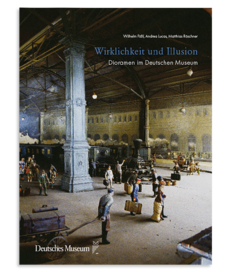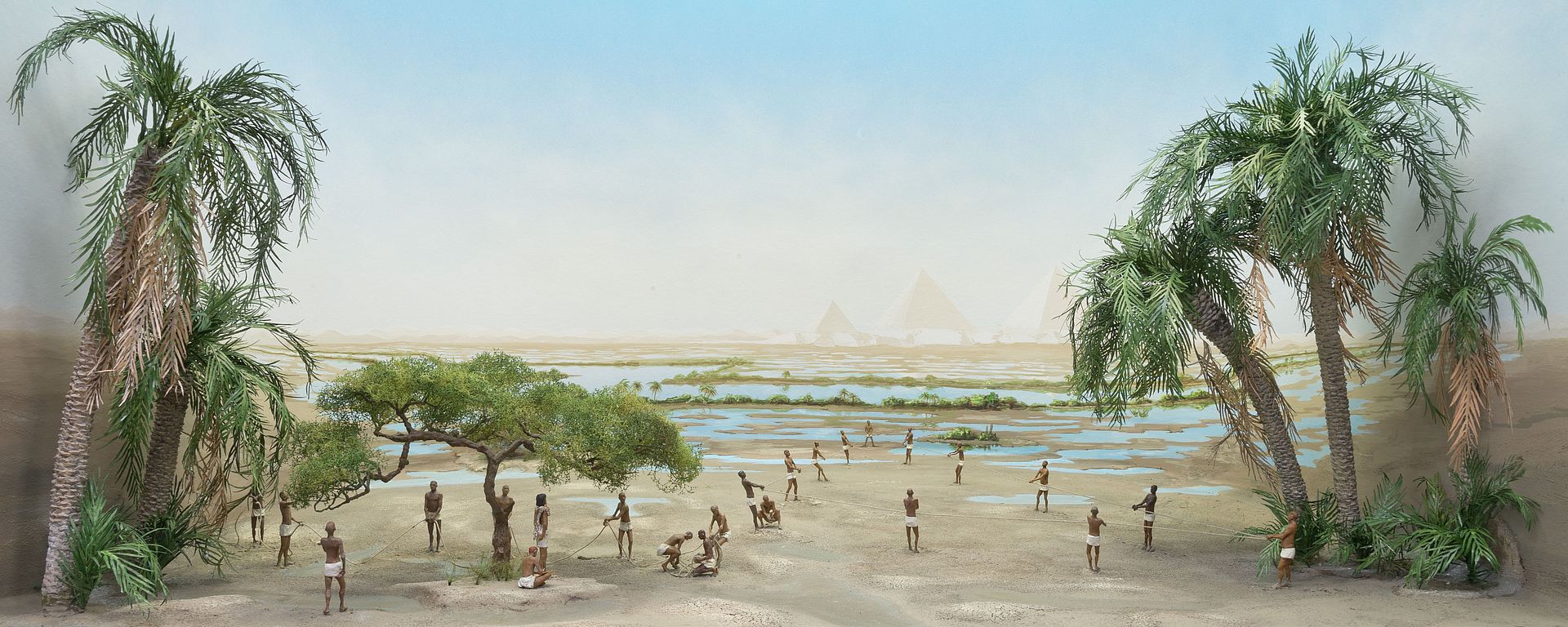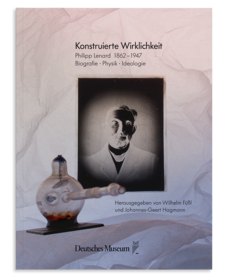

Photo: Deutsches Museum
Masterpieces from our workshops
Dioramas in the Deutsches Museum
Works of art with attention to detail and close to science: The dioramas are made in our workshops and are a special feature in the exhibitions of the Deutsches Museum – fascinating and educational.
Museum founder Oskar von Miller found that you can better imagine many things when you see them in their normal surroundings. That's why there are dioramas in almost every exhibition in the Deutschen Museum. These are fascinating miniature worlds in a showcase that take you to ancient Greece or an icy North Pole expedition or depict a landing on the moon. Most of the dioramas were built in the museum's workshops.
Exhibition Image Script Codes
Diorama "Enigma-Nutzung im Wald Ostfront 1941, Diorama 2-teilig", Inv.Nr. 2024-0054 Photo: Deutsches Museum, München | Hubert Czech
Cipher unit on the Eastern Front in 1941
Two men from a cipher unit are encrypting a message using an Enigma: One enters plaintext, letter by letter. The other notes down the ciphertext letters that light up on the Enigma’s lamp panel.
A radio operator is ready and waiting in the radio car to send the message in Morse code, while a fellow soldier uses a pedal generator to power the radio and the Enigma.
This diorama can be found in the Image Script Codes exhibition on Level 2.
Exhibition Bridges and Hydraulic Engineering
Diorama "Müngstener Brücke", Inv.Nr. 1996-0463 Photo: Deutsches Museum
Müngsten Bridge
The Müngsten Bridge is the largest truss arch bridge in Europe.
It was one of the prestige projects of Kaiser Wilhelm II, who always tried to outdo France: That's why it is ten meters wider than Gustave Eiffel's Garabit Viaduct (1884), which served as a model. However, in 2023 they are both on track for shared World Heritage status, along with four similar structures in Portugal and Italy. The main work on the arch assembly shown in the diorama took place in the stormy winter months of 1896 and 1897.
Diorama, scale 1:100
Year of construction: 1996
Manufacturer: Birmann Modellbau, Nürnberg und Werkstätten des Deutschen Museums
Donation: MAN AG, München
Inv.-Nr. 1996-0463
This diorama can be found in the Bridges and Hydraulic Engineering exhibition on Level 0.
Diorama "Wehrbaustelle Oberried", Inv.Nr. 1997-0235 Photo: Deutsches Museum, München
Oberried military construction site
Sheet pile walls allow concrete to be poured in the middle of the river.
In Oberried an der Günz, Swabia, in 1994 and 1995
an old weir from 1899 was replaced by a new system.
The construction status is shown in the summer of 1995 during flooding:
The first weir field and the diversion have already been completed.
Sheet pile walls secure the construction site and make this possible
Concreting the additional weir fields in the dry.
Meanwhile, parts of the old system are still in operation.
This diorama can be found in the Bridges and Hydraulic Engineering exhibition on Level 0.
Diorama "Oberstufe Glockner-Kaprun im Bau", Inv.Nr. 75256 Photo: Deutsches Museum, München | KMosch
Glockner-Kaprun upper stage under construction
View of the Moosersperre as it was constructed in 1953
The Mooser lock (front) and the Drosser lock (rear)
form the Mooserboden reservoir in the Kaprun Valley in Austria.
The Glockner-Kaprun power plant group includes several such barrages. There were already plans for this in the 1920s,
However, they were not realized due to the economic crisis.
After Austria was annexed to Nazi Germany in 1938, work began under National Socialist leadership.
The background was the high energy requirements of the armaments industry. Thousands of forced laborers were used, many of whom died. Due to a lack of building materials, work was stopped in 1944.
With financial support from the USA from the Marshall Plan
Construction work resumed in 1948.
The working and living conditions in the high mountains were harsh.
The enormous dimensions of the project gave rise to a myth
which was glorified in the press, literature and film. Kaprun became one for the young Republic of Austria
identity-creating project and symbol of reconstruction after the Second World War.
This diorama can be found in the Bridges and Hydraulic Engineering exhibition on Level 0.
Exhibition Electronics
Diorama "HP Garage", Obj.Id. 837893 Photo: Deutsches Museum
Silicon Valley’s Birthplace
In 1939, two graduates of Stanford University, W. Hewlett and D. Packard, founded the Hewlett-Packard Company. They started out in a small garage in Palo Alto, California, initially focussing on testing and measuring instruments. This garage in Palo Alto is considered the birthplace of today’s Silicon Valley.
This diorama can be found in the Electronics exhibit on Level 2.
Photography and Film exhibition
Diorama "Atelier-Photograph um 1860", Inv.Nr. 69300 Photo: Deutsches Museum
Studio photography around 1960
Soon after the introduction of photograhy, studios offering portrait photography were opened in the cities. As artificial lighting was not yet available, photographers had to rely on natural light. Glazed wall and roof sections facing north were ideal.
This diorama can be found in the Photography and Film exhibition on level 2.
Health exhibition
Diorama "Ether-Tag", Inv.Nr. 2020-0201 Photo: Deutsches Museum
First operation under anesthesia
On October 16, 1846, the first operation under general anesthesia was performed at the Massachusetts Hospital in Boston. The dentist William Thomas Green Morton anesthetized the patient with ether using a device he had developed. This day went down in medical history as “Ether Day”.
This diorama can be found in the Health exhibit on Level 3.
Exhibition Historic Aviation
Diorama "Roald Amundsens Nordpolexpedition mit dem Flugboot Dornier Wal", Inv.Nr. 73929 Photo: Deutsches Museum, München | RKrause
North Pole expedition by Amundsen with Dornier “WAL” flying boat (1925)
Led by the polar explorer Roald Amundsen, six men set off for the North Pole in two Dornier WAL flying boats on May 21, 1925. They had to make an emergency landing in the ice 250 km from their destination. For four weeks, the men made one of the WALs airworthy again and drove a runway into the pack ice. The take-off - and thus the rescue - was successful! On June 18, 1925, they reached their starting point on Spitsbergen.
This diorama can be found in the Historical Aviation exhibition on level 1.
Diorama "Segelflugschule Unterwössen", Inv.Nr. 77074 Photo: Deutsches Museum, München | KMosch
Unterwössen gliding school (around 1960)
The diorama shows the Unterwössen gliding school in the Chiemgau Alps. Gliders have been able to complete their training there since 1954. As gliders do not have their own propulsion, they need help to get into the air. Winch launching and aerotowing are among the most frequently used launching methods in Germany. The diorama shows both methods.
This diorama can be found in the Historical Aviation exhibition on level 1.
Diorama: Prüfstand VII Peenemünde, Inv.Nr. 77948 Photo: Deutsches Museum, München | KMosch
Test stand VII at the Peenemünde military testing facility
Peenemünde on the Baltic Sea island of Usedom: hidden among the pine trees was Test Stand VII, where scientists led by Wernher von Braun carried out rocket tests with the A4, later “V2”, terror weapon from 1938 to 1945. After the war, the rocket engineers glorified the terror weapon forge as the “cradle of space travel”. The historical camouflage patterns are therefore missing on buildings and vehicles in the diorama.
This diorama can be found in the Historical Aviation exhibition on level 1.
Agriculture and Food exhibition
Diorama "Monoculture/three-field crop rotation", Obj.Id. 832088 Photo: Deutsches Museum | Christian Illing
Always the same or always different? Monoculture or crop rotation?
In the early Middle Ages, three-field crop rotation characterised European agriculture. Winter crops, summer crops and unplanted fallow land were rotated on three fields. This replenished the fertility of the soil, protected plants against disease and pests, and increased crop yields. The fallow land was used as a paddock; those who farmed had to keep animals so they had manure to fertilise their crops. It was not until the 18th century that potatoes, sugar beets and forage crops replaced the fallow – and thus began modern crop rotation.
Be it corn fields in the USA, Andalusia, rice terraces in Vietnam or asparagus fields in Germany, in so-called monocultures (above), only a single crop type is grown year after year. Although this specialisation makes nurturing and harvesting easier, years of growing the same crop can disturb the ecological balance. The nutrients in the soil are used up, while the unvaried planting offers pathogens, weeds and pests the best conditions to thrive, and biodiversity suffers. Pesticides and fertilisers are used in order to guarantee good crop yields.
This diorama can be found in the Agriculture and Food exhibition on level 3.
Diorama "Vertical Farming", Obj.Id. 846315 Photo: Deutsches Museum | Christian Illing
From horizontal to vertical: growing under glass
Fresh tomatoes, cucumbers and peppers can be found in European supermarkets even in winter. Most originate from greenhouses in the Netherlands and Spain. Dutch companies tend to rely more on heated glasshouses; plants thrive here, isolated from the weather, pollutants and pests. Whereas in Spain, where it is relatively warm, a simple plastic film covering is sufficient. But irrigation is depriving this dry country of important water resources.
Demand for local products is rising in expanding cities. In indoor vertical farms, space is saved by growing plants on tiers, where they thrive without sunlight, soil or pesticides. Lettuce, tomatoes and herbs grow under LED lamps, where their roots are automatically sprayed with water and nutrients. However, the heat and light required to grow the plants makes them costly and energy consuming.
This diorama can be found in the Agriculture and Food exhibition on level 3.
Diorama "Agroforestry", Obj.ID. 832087 Photo: Deutsches Museum | Christian Illing
Fertile community: agroforestry
In the past, the forests of Central Europe also served as pastures or as places for pig fattening. Trees were also a common sight in many fields, marking boundaries, protecting against erosion and providing fruit. But these traditional agroforest systems started to lose importance in the 19th century.
Today, woodland is being brought back to fields all over the world. In modern agroforestry systems, field plants share space with valuable timbers such as cherry wood or fastgrowing trees that are used for energy production. Sufficient space is left between rows of trees to enable agricultural machinery to pass through.
This diorama can be found in the Agriculture and Food exhibition on level 3.
Mathematics exhibition
Diorama "Landvermessung in Ägypten, Mittleres Reich", Inv.Nr. 2024-0055 Photo: Deutsches Museum
Geometry in the Pharaonic Kingdom
Egyptian surveyors stretch a rope with twelve knots to stake out a right angle – according to Pythagoras. Every year, the Nile flooded the fields. To ensure that the taxes for the pharaoh were correct, Egypt's surveyors had to constantly remeasure the fields. The Egyptians thus became early masters of geometry.
This diorama can be found in the Mathematics exhibition on Level 2.




